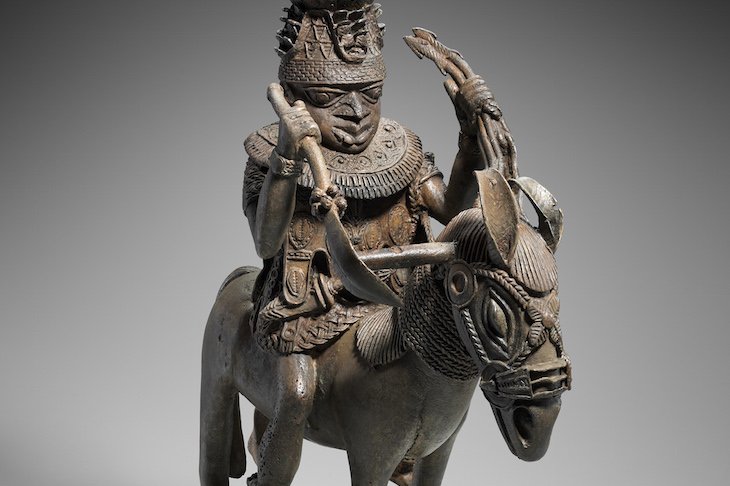
Image taken from Apollo Magazine
Mounted ruler (16th century), Edo peoples, Benin kingdom, Nigeria. Courtesy Museum of Fine Arts, Boston
Article written by Ssiima Sematimba and Keketso Dibakwane.
Edited by Kamdi Okonjo
Benin Empire
In the rich tapestry of African history, numerous empires have flourished, yet sadly, many remain unrecognized or overlooked in contemporary education.
Among these remarkable African empires, the Benin Empire stands out with its illustrious history, vibrant culture, and unparalleled artistic achievements. However, as with the ebb and flow of great endeavors, the glory of the Benin Empire eventually waned, marking the passage of time and the inevitable transitions of history.
Image taken from The Guardian
Location of Benin Empire
The Kingdom of Benin, situated in the lush forests of southern Nigeria, represents a significant historical and cultural heritage. The kingdom's location in present-day Nigeria, bordered by Niger to the north, Chad to the northeast, Cameroon to the east, and Benin to the west, reflects its strategic position in West Africa. Unfortunately, during the colonial era, Benin City, the kingdom's capital, was tragically destroyed by the British as they sought to incorporate it into British Nigeria. In contemporary times, the Oba, or king, of Benin serves as a revered figure and advisor in the government of Benin City, now officially known as the Republic of Benin. This transition reflects the evolving nature of the kingdom, retaining its historical legacy while adapting to the modern era.
Kingdom History
The history of the Benin Empire spans various stages, encompassing multiple years and distinct sections, as it emerged through the annexation and unification of smaller kingdoms, a common pattern in the formation of empires. The Benin Empire comprised three major kingdoms: Allada, Abomey, and Porto-Novo, and it once stood as a remarkable and influential empire in history. However, its legacy was marred by its involvement in the African slave trade, which transformed the kingdom's coastline into the infamous 'Slave Coast,' where numerous Africans were captured and traded as slaves to the Americas, marking a tragic chapter in its history.
In 1872, the Benin Kingdom was colonized by the French, who renamed it 'Dahomey' and incorporated it into French West Africa. The period from the late 1950s to the late 1980s witnessed a global shift towards decolonization, with numerous African countries gaining independence and self-government as colonial powers relinquished control. On December 4, 1958, Dahomey achieved self-governance, and in 1960, it attained full independence and became a member of the United Nations.
However, the path to independence for Dahomey was not without challenges. Following independence, the country experienced a period of political instability, marked by six coups. In 1975, under the leadership of Major Mathieu Kerekou, the military renamed the nation the People's Republic of Benin, replacing the colonial name 'Dahomey' as part of a larger ideological shift.
The transformation of the Benin Empire into Dahomey and later the People's Republic of Benin reflects the complex historical and political changes that shaped the region, highlighting the struggles and aspirations of its people in the pursuit of independence and self-determination.
Taken from The MET Museum
Benin Society
The Benin Empire, formed through the amalgamation of three distinct kingdoms - Allada, Abomey, and Porto-Novo - showcases the fascinating history of West Africa. Allada, a powerful kingdom in Ajaland, flourished until it was eventually defeated by the Dahomey army in the 16th century. In the same era, the Kingdom of Abomey and its people became assimilated into the growing Dahomey empire. Porto-Novo, believed to have emerged in the late 16th century, later joined forces with Benin, solidifying the empire's territorial expansion. The Benin Empire primarily consisted of the indigenous Edo people, who formed the heart of its population.
Religion played a vital role in the lives of the Benin people, and their culture was deeply intertwined with their spiritual beliefs. Voodoo held significant importance within the Benin Empire, shaping their rituals, ceremonies, and daily practices. The Benin people took immense pride in their rich folklore and oral traditions, which encompassed a wealth of captivating stories and folktales that were passed down through generations, offering insights into their history, values, and worldview.
One of the notable aspects of the Benin Empire was its remarkable artistic legacy. The Benin artists were renowned for their exceptional craftsmanship and creative prowess. They demonstrated mastery over various materials, including brass, wood, and ivory, skillfully transforming them into intricate sculptures and artworks of breathtaking beauty. The Benin Empire's artistic traditions encompassed an array of art forms, such as bas-reliefs and life-size head sculptures. These sculptures, particularly the lifelike heads, became iconic symbols of Benin's artistic excellence, revered for their exquisite form, attention to detail, and aesthetic precision.
The artisans and merchants of Benin played a pivotal role in the empire's vibrant trade networks. Their exceptional artworks and sculptures garnered attention and admiration, attracting foreign traders, particularly the Portuguese, who formed enduring relationships with the Benin people. The Portuguese were captivated by the artistic treasures produced in Benin, fostering a cultural exchange that enriched both societies and contributed to the kingdom's prosperity.
Thus, the Benin Empire stands as a testament to the cultural richness, artistic ingenuity, and historical significance of the people who resided within its borders.
Benin Empire’s contemporary significance
Today, the Benin Empire continues to hold a significant place in Nigerian history, standing as one of the world's remarkable empires. It is truly extraordinary to witness 16th-century kingdoms still functioning as active entities in our contemporary society. Presently, the Benin Kingdom is officially recognized as the Republic of Benin, a tropical nation that exports substantial quantities of cotton and palm oil to countries around the globe. The Republic of Benin is home to more than ten distinct ethnic groups and boasts an impressive array of 39 national languages, reflecting its cultural diversity and linguistic richness.
Benin is a country that exudes a vibrant cultural tapestry, with music, art, and traditions that captivate and inspire. It is the birthplace of the world-renowned Angelique Kidjo, a Beninese singer-songwriter and activist who has earned multiple Grammy Awards. Kidjo's creative prowess encompasses a diverse range of musical influences, and her evocative videos further elevate her artistry. Reflecting on the cultural and heritage treasures of the Benin Kingdom, Angelique Kidjo encapsulates its essence with a quote that resonates deeply:
"The music of the westerner comes from Africa whether they like it or not. The majority of the instruments of the music, of pop music, rock and roll, or R&B, whatever it is, their roots trace back to Africa. So, if you are black, white, yellow or red, whatever you do, it doesn’t matter, because your DNA is back in Africa"
Indeed, the Republic of Benin stands as a testament to the enduring legacy of the Benin Empire, showcasing a country enriched by its cultural heritage, renowned artistry, and a tapestry of traditions that continue to shape its vibrant present and promising future.
References
Dr Toby Green, “The Kingdom of Benin 1500-1750”, 27th March 2019. Available at: https://history.org.uk/podcasts/categories/441/podcast/585/the-kingdom-of-benin-1500-1750
Abraham, Correct NG. “CORRECTNG WIKI30 Interesting Facts About The Great Benin Kingdom You Didn’t Know”; October 18, 2019. Available at: https://www.correctng.com/30-interesting-facts-about-the-great-benin-kingdom-you-didnt-know-30/
Iexplore. “Benin — History and Culture”. Available at: https://www.iexplore.com/articles/travel-guides/africa/benin/history-and-culture
One World - Nations Online. “Benin History Timeline”. Available at: https://www.nationsonline.org/oneworld/History/Benin-history-timeline.htm
Cartwright, Mark. "Kingdom of Benin." World History Encyclopedia. Last modified April 02, 2019. Available at: https://www.worldhistory.org/Kingdom_of_Benin/.
Wu Mingren. “The Benin Bronzes: A Tragic Story of Slavery and Imperialism Cast in Brass”. 1 May 2021. Available at: https://www.ancient-origins.net/artifacts-other-artifacts/benin-bronzes-008565
Ed Whelan. “Royal Palaces of Abomey, Benin: The Cultural Epicenter of One of Africa’s Greatest Empires Was Stained with Blood”. 5 January 2019. Available at: https://www.ancient-origins.net/ancient-places-africa/roya-palaces-abomey-0011284
Plankensteiner, B. "Benin: Kings and Rituals: Court Arts from Nigeria." African Arts, Vol. 40, No. 4 (Winter, 2007), pp. 74-87.
Zeijl, Femke van. "The Oba of Benin Kingdom: A history of the monarchy". Available at: www.aljazeera.com
Law, Robin (January 1985). "Human Sacrifice in Pre-Colonial West Africa". African Affairs. 84 (334): 65.
Igbafe, Philip A. (1970). "The fall of Benin: a reassessment". Journal of African History. 11 (3): 385–400. doi:10.1017/S0021853700010215. JSTOR 180345




